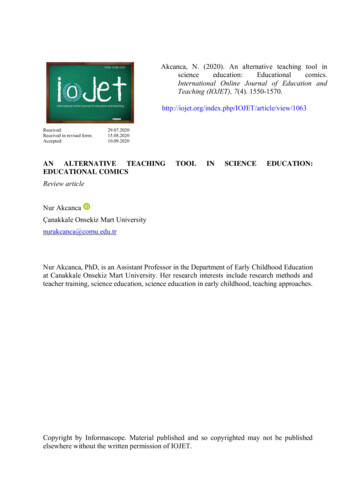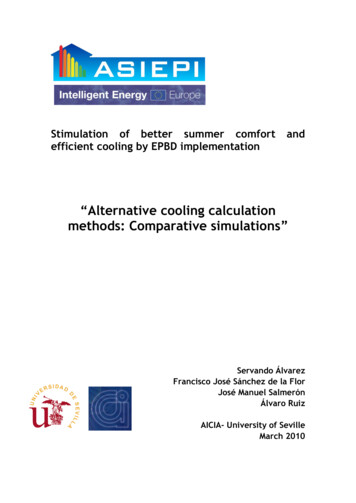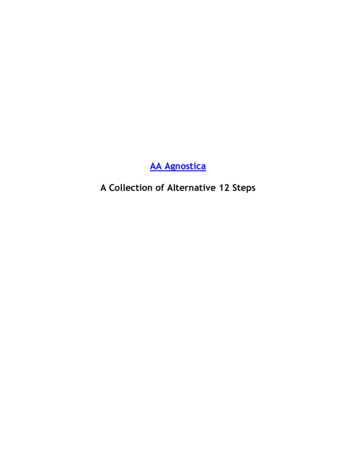
Transcription
Akcanca, N. (2020). An alternative teaching tool inscienceeducation:Educationalcomics.International Online Journal of Education andTeaching (IOJET), 7(4). /view/1063Received:Received in revised form:Accepted:29.07.202015.08.202010.09.2020AN ALTERNATIVE TEACHINGEDUCATIONAL COMICSTOOLINSCIENCEEDUCATION:Review articleNur AkcancaÇanakkale Onsekiz Mart Universitynurakcanca@comu.edu.trNur Akcanca, PhD, is an Assistant Professor in the Department of Early Childhood Educationat Canakkale Onsekiz Mart University. Her research interests include research methods andteacher training, science education, science education in early childhood, teaching approaches.Copyright by Informascope. Material published and so copyrighted may not be publishedelsewhere without the written permission of IOJET.
AkcancaAN ALTERNATIVE TEACHING TOOL IN SCIENCE EDUCATION:EDUCATIONAL COMICSNur Akcancanurakcanca@comu.edu.trAbstractComics, which attract attention with their adaptation to changing conditions in the historicalprocess, are increasing their popularity both in current life and in the field of education. Theycan be used as a powerful supplementary teaching tool concretizing abstract concepts,especially in lessons such as Science. They can also be used to convey abstract concepts tostudents in an entertaining way. From this point of view, the study aimed to reveal the generalcharacteristics, structure, elements, and historical development of comics at a theoretical level.The study, which adopted a qualitative research design, was based on a wide range of aliterature review focusing on comics in an educational context as alternative resources to usein science education. The data collected were coded, grouped, and reorganized as a report topresent within the context of science education for the teachers who might plan to use comicsin their classes, and researchers who might scrutinize the influence of comics in teachingscience at different levels.Keywords: Comics, supplementary tools, education and training, science education, abstractconceptsIntroductionCurrent developments in the field of education in the 21st century have led to a series ofchanges in our understanding of education. Meeting our teaching needs in our age has led tothe necessity of preparing teaching materials with a new perspective in the classroom wheremodern education and training practices are performed together. It is possible to mention manypositive effects of teaching materials such as increasing efficiency in the classroom, activeparticipation of students (Tekmen, 2016), and providing permanent learning (Aşçı, 2020).The most used course material in the process of gaining scientific knowledge of science isundoubtedly the textbooks prepared in accordance with acquisitions in the program. Textbooksallow the subject to be handled systematically as a guide both for teachers and students (Ünal& Demirkaya, 2019); however, in lessons such as science, which has abstract concepts whichare difficult to understand, using only the textbook and not supporting it with other coursematerials may decrease students' interest in the lesson or decrease efficiency.At this point, we come across comics that are becoming more and more popular in the fieldof education (Lazarinis, Mazaraki, Verykios & Panagiotakopoulos, 2015; Topkaya, 2016). Thecombination of images and texts in comics helps students to see the process more attractive bychanging their perspective on learning processes (Astuti, Kismini & Prasetyo, 2014). In thisrespect, different researches have revealed that using comics as a teaching material will havepositive contributions to the learning-teaching process (Mamola, 2019; Yang, 2003). In orderto understand comics better, it is necessary to express how they are defined, to discuss theirfeatures and elements, and to include examples in the historical process. In addition, it isthought that focusing on the use of comics by addressing the role of comics in educationalenvironments will be beneficial for teachers who will use them in their lessons.1550
International Online Journal of Education and Teaching (IOJET) 2020, 7(4), 1550-1570.1.ComicsRapid technological developments and changes in our age change our perspective onteaching materials used in education and training environments. Comics, which have becomepopular in recent years thanks to their content and visuality, are one of these teaching materials.Studies refer to the difficulty of making a general description of comics. Emphasizing thisissue, Kireççi (2008) suggests that comics can only be defined according to the current cultureand time. At this point, it is important how Rodolhe Töpffer, who is considered to be thefounder of modern comics and is also an art critic and educational scientist, defines comics. Itis seen that Töpffer describes comics as a consecutive communication tool on a paper withimages and texts and points out that the text would be incomplete without the image and thatthe image would be incomplete without the text (Paltani-Sargologos, 2011). Comics can alsobe defined as an art of fiction in which a narrative style, formed by the combination of twomain elements, text and image, is adopted (Cantek, 2016). In another definition, it is mentionedthat comics convey realistic or imaginary ideas by using visual images, and the humour aspectis also emphasized while conveying important messages (Toh, Cheng, Jiang & Lim, 2016).Looking at the definitions, it is seen that the researchers emphasized the combination of textand image. What needs to be noted here is that this combination comes together with a realcomposition, not as a simple match (Kunzle, 1973). In this case, it would not be wrong to saythat comics consist of neither an image nor a text and that they are a synthesis which is achievedby combining images and texts (Cihan, 2014).The comics industry has gone through many historical stages. Considering the term comicsin general, it will be possible to divide them into branches such as graphic novel, newspaperstrips, single-panel gag cartoon, superhero comics, web comics, manga, underground comics,alternative comics, and western comics (Bıçakcı, 2018). It is thought that comics, which areaccepted as an art type formed in the modern age, carry the function of images and visuals onestep further by including the text in the process (Orçan & Kandil İngeç, 2016). The purpose ofcomics, which contain intentional images created by the combination of side-by-side images,may be to convey information to the audience or to produce only an aesthetic response(McCloud, 1993).Comics are a form of storytelling. They use a series of static images while presenting a storyas a tool (Lazarinis et al., 2015). Unlike regular books, paintings, or movies, it would not becorrect to characterize comics as better or worse than other genres; however, it should beadmitted that they differ from other genres (Karczewski, 2013). It is important to reveal thebasic characteristics of comics which are shaped by a writer in order to understand them better.The basic features of comics are given in Figure 1.1551
AkcancaComics are a type of story in which images that support each othercreate a series of subject integrity and fit into a short timeline.Commonfeatures ofcomicsIn comics, fictional elements such as relationships, manners,emotions and thoughts, place and time, and cause and effectrelationships are expressed with images and drawings.In comics, characters often have features that repeat each other.In comics, speech or text is included in the image, and the image andtext form a whole. Comics dominated by pictures or texts can alsobe seen.Figure 1. Common features of comics (Cantek, 2014; Uslu Üstten, 2014)Considering the basic features in Figure 1, it is seen that the image in comics is at least asimportant as the story. At this point, it would be appropriate to mention a specific structuralfeature of comics. For the meaning integrity of comics, the relationship between the frames isimportant rather than the image in the frame. The meaning of comics in the spaces betweentwo sequential images is related to the human mind. We complete the story of comics ourselvesby creating what is not written and drawn on paper or what does not exist, in our mind. Thereason for this is that our mind constructs meaning by establishing a connection between thetotal symbols formed by written and visual texts while transitioning from one frame to another(Gündüz, 2004). This connection is important for comic book readers to have actions in theirminds more easily and to achieve meaningful and permanent learning (Akkaya, 2013).1.1. Comics in Historical TimelineResearchers have different comments and opinions regarding how old the history of comicsare. According to some, the birth of comics is based on hieroglyphs in ancient times, whilesome other researchers point out that comics are based on illustrations in Leonardo da Vinci'snotebook (McCloud, 1993; McCloud & Manning, 1998). However, comics are neither justimages nor texts (Derdiyok, 2019). For this reason, there is no consensus on the starting pointof the historical process of comics. One of the most important factors affecting the developmentof comics is undoubtedly the presence of a printing house. With the advent of the printingpress, over time, pictures have taken on a complementary role to stories. It is, therefore, notsurprising that the object was ultimately combined with art to make illustrated and narratedseries (Olson, 1993).Comics first became known in France and Belgium in the 1800s. The work named "Voyageset aventures du Docteur Festus" (Travels and Adventures of Doctor Festus), which is the firstcomic book in history, was completed in 1831 and was published in 1840 with the signature ofRudolphe Töpffer (Gündüz, 2004).1552
International Online Journal of Education and Teaching (IOJET) 2020, 7(4), 1550-1570.Figure 2. A section from the comic book named "Voyages et aventures du DocteurFestus" (Project Gutenberg Canada, 2013)In the comic book seen in Figure 2, it is seen that the image and text are given together. Inaddition, Töpfer chose space travels with his imagination as the subject of his stories (Olson,1993). A few years later, in 1854, French artist Gustave Doré published “L'Histoire de la SainteRussie”, a series of 477 consecutive drawings which describe the history of Russia. Around1865, Wilhelm Busch published "Max and Mauritz", the story of two malevolent children andtheir hardship and final punishment. This comic book, which has a colourful image on almostevery page in addition to the text, had been popular for a long time (Olson, 1993). "LesAventures de Tintin" (The Adventures of Tintin), published by Georges Lemi in the 1920s, isa comic book that achieved a significant success in those years (Uslu Üstten & Pilav, 2016).An example section of this comic book is given in Figure 3.Figure 3. A section from the comic book named "Les Aventures de Tintin"With these developments in the historical processes, comics, which created a readership inEurope, first appeared in the United States in the modern sense at the end of the 19th century(Aşçı, 2020; Symeon, 2008). For the first time, Rudolph Dirks published the comic book "TheKatzenjammer Kids" for the New York Times on December 12, 1897 (Armor, 1987).Meanwhile, comics in England developed under the influence of American publications, whileGermany fell behind in the field of comics due to the social and economic conditions thatemerged after the war (Uslu Üstten & Pilav, 2016).In our country, the first comics entered our lives after the First World War. When the firstcomic book examples in Turkey are considered, it is seen that the character of “Amcabey”1553
Akcancadrawn by the cartoonist Cemal Nadir Güler in 1929 is important. The main character of thiscomic book is given in Figure 4.Figure 4. The main character in the comic book named "Amcabey" by Cemal NadirIn the following years, the magazine named "Binbir Roman" published in Istanbul made animportant contribution with its comic book content compared to the developments in the period(Kurt, 2019). It can be stated that qualified publications started with "Phantom" in the 1940s.In the following years, comics, which won the appreciation of our country's readers, started toappear in newspapers, especially with series of drama, adventure, love, and comedy. With thepublication of colorful magazines depicting western heroes such as Mandrake, Zagor, MisterNo, Flash Gordon and Tarzan, a serious comic culture was formed in that period (Çetin, 2010).Turkish comics tradition, which started with the translation method at first, later had a realistic,rational, local, and national direction that fed on Turkish history (Karagöz, 2018).When we look at the historical process of comics, it is understood that they were acceptedas a second-class type of literature or a low art form for a period, and they did not, therefore,see the value they deserved (Jacobs, 2007; Upson & Hall, 2013). The fact that comics mostlyconsist of images and that they do not deal with subjects deeply is accepted as the main reasonsfor being unfairly ignored (Tatalovic, 2009). In addition, it was suggested that comics weredesigned for children, people who did not like reading, or adults clinging to adolescence (Loet al., 2019). For these reasons, there was a tendency among many educators and parents tobelieve that comics were created only for entertainment purposes and had little or no realeducational and literary values (Lo et al., 2019). In fact, these beliefs at first prevented the useof comics in the education and training process. To exemplify, similar situations wereexperienced during periods when it was considered objectionable to teach comics in schools,and it was prohibited to read comics during the education process (Toh, Cheng, Ho, Jiang &Lim, 2017). Comics were traditionally seen as the "enemy" of schools, and students caughtreading comics in schools were referred to the disciplinary committee (Cleaver, 2008).However, these periods did not last long, and comics, which are now appreciated as apotentially important educational tool to attract students' interest in various academic subjects,have regained the value and importance they have deserved (Tilley, 2008; Lo et al., 2019).Today's comic books, which are more entertaining and engaging than the ones in the pastand include subjects for adults, have significantly increased their popularity through comicbook films and television series in recent years (Çetin, 2010). The Road to Perdition, GhostWorld, Incredible Hulk, Sin City, X-Men, The Fantastic Four and Snowpiercer are among thecomics adapted into films. With these films, which are the adaptations of comic book stories,the educational value of comics, which have proven their influence on popular culture, hasbegun to be re-evaluated by different researches (Lo et al., 2019).1554
International Online Journal of Education and Teaching (IOJET) 2020, 7(4), 1550-1570.1.2. Elements of ComicsComics have elements that ensure the integrity of their unique structures. These elementsthat make up comics are shown in Figure 5 (Tuncer, 1993).Elements of ComicsCharacter inComicsLanguage inComicsTime in ComicsThemes inComicsGraphic Elementsin ComicsFigure 5. Elements of comicsThe elements that make up comics will be explained under separate titles.1.2.1. Character in comicsCharacter is the main element of comics. For this reason, many comics are named after theircharacters (Kireççi, 2008). The story narrated in comics is processed through characters;therefore, characters are important for the reader. Characters are in favour of goodness, directand order (Sarıbıyık, 2018). The reader feels close to and embrace characters for a reason. Infact, the reader can sometimes experience the character's emotional state in their inner world.Although comic book heroes are mainly selected from male characters (such as Batman andSuperman), there are also comics (such as Black Widow and Wonderwoman) in which femaleheroes are the main characters (Mutlu, 2019; Tuncer, 1993). The main character can be maleor female, as well as a plant or an animal. For example, "Snoopy", a comic book whose maincharacter is a dog, thinks and speaks like a human.1.2.2. Language in comicsIt is possible to say that comics have a special language of expression. Thanks to therelationship between the frames, the idea to be conveyed is expressed clearly. In the spacesbetween the panels, the connections established on the basis of the reader's mind make the storycomplete by creating a part that is not drawn in the mind (Güdek, 2019). For this reason, it isvery important to use a language based on visual experience that will attract the attention ofthe reader (Eisner, 2008). If we think of comics as a means of communication, the languagecreated with text and images must find its counterpart in the imagination of the reader in orderfor communication to take place (Yavuz, 2011).The language used in comics acts as a bridge between everyday language and academiclanguage, which is thought to positively affect the success in the lesson (Krashen, 1993). Incomics, language and expression are shown in speech and thinking bubbles. Understandingwho it belongs to is provided by directing an arrow from the bottom of the balloon towards thehead of the character (Sarıbıyık, 2018).1555
AkcancaFigure 6. Speech bubbles used in comicsWhen the reader see the text or balloons, they understand that the character whispers (thelines that make up the speech bubble are broken), speaks loudly or shouts (text written in boldand capital letters without a speech bubble), or even thinks (the speech bubble looks like acloud and small bubbles reaching out to the person it belongs to) (Sarıbıyık, 2018).1.2.3. Time in comicsTime is flexible and unlimited in comics; therefore, it can be directed backwards or forwards(Sarıbıyık, 2018). It is possible to travel in time thanks to the writer in comics. It is thought thatexperiencing and transferring stories in comics in the present time attract the attention of thereader (Tuncer, 1993).Comics inform the reader about the time they are in. Details such as the dressing style ofcharacters, the architectural features of the place where the story takes place, the elements oflife, the presence/absence of technological products, the primitiveness/modernity of the toolsused are given both to reflect the time to the reader in a detailed and impressive way and toconnect the reader to the story more. For example, in the comic "Redkit", the story takes placeat the end of the 19th century. The time involved in the comic book story affected thecommunication method in the story. It is seen that Redkit often uses telegrams to communicate.For transportation, besides the horse carriage, a train road draws attention (Yavuz, 2011). Withsuch visual schemes, it can give information to the reader about those periods about which theydo not have much information (Sarıbıyık, 2018).1.2.4. Theme in comicsThe value judgments of societies are different from each other. Comics are also influencedby the characteristics of the society in which they originate, and are often used to comment oncurrent issues (Tatalovic, 2009). Different comics have been developed on different subjectsfor various educational purposes at educational levels (Lazarinis et al., 2015). Comics dealingwith history, politics, or bureaucracy can be classified within the framework of adventure,politics, and history. Classification of comics around a category can create a certain audience(Sarıbıyık, 2018). Throughout the historical process, themes in comics started with simplestories and later left their place to superheroes. After the World War I, superheroes started tolose interest and comics dealing with topics such as crime, thriller and science fiction came tothe fore (Aşçı, 2020).Comics present themes to the reader with the method of uninterrupted illustration. It isthought that it will be beneficial to reveal the details of the message that is desired to be givento the reader if the main message is presented briefly and concisely (Topkaya, 2014). The factthat people tend to and prefer topics that attract people's attention has made the concept oftheme in comics one of the determining factors for the preference of the readership.1556
International Online Journal of Education and Teaching (IOJET) 2020, 7(4), 1550-1570.1.2.5. Graphic elements in comicsIllustrations in comics have a strong effect on keeping the story alive to the reader. Visualsin comics are effective in guiding readers' perception of spatial relationships within a certaincontext (Pratt, 2009). Preserving the balance between the text and the image in comics and thefact that writing does not dominate when telling the story are significant and should beconsidered (Sarıbıyık, 2018). Having more text disrupts the follow-up feature of continuitybetween the images and makes it boring (Cantek, 2014).The use of images in comics is effective in terms of improving students' ability to constructinformation with more than one method (Bolton-Gary, 2012). This is very important forstudents to prepare for their future life (Toh et al., 2017).2.The Relationship Between Comics and Other DisciplinesDifferent disciplines communicate with each other. This context supports each other andenables the development of related disciplines (Sarıbıyık, 2018). In this section, the interactionof comics with education will be examined.2.1. Comics in the Education ProcessWhen we look at the historical development of comics, it is seen that they were firstpublished in newspapers and magazines and then published in print. Later, educational andinformative elements were added to the contents of comics, as a consequence of which theywere used in the field of education (Karagöz, 2018). This new genre was named "educationalcomics".Comics can be used as an important and powerful supplementary teaching tool in variouseducational environments (Berkowitz & Packer, 2001; Cimermanová, 2015; Rajendra, 2015).In this respect, the potential of comics in the education and training process emerges as asubject worth researching (Marianthi, Boulodakis & Retalis, 2016). In fact, the use of comicsas a tool in education is not new (Owens, Eno, Abrams & Bedney, 2020). The basis of usingcomics in education is based on the binary coding theory of Clark and Paivio (1991). Thistheory, which supports the importance of images in cognitive operations, is based on thedevelopment of recall and recognition by presenting information both visually and verbally(Marianthi et al., 2016).Comics are generally used as an educational material or activity in a visually enrichedformat, preserving the features mentioned in the definitions in education and trainingenvironments (Akkaya, 2013; Joshi et al., 2019). It is thought that, if comics are prepared inaccordance with two sound pedagogical principles, comics will support students' learning. Thefirst is to position stories that might be interesting for students in a certain context, whereas thesecond is to establish a meaningful bridge between the concepts discussed and the students'real life (Toh et al., 2016).Since educational comics contain two very rich forms of cultural expression, the arts ofliterature and painting, students actively participate in the learning process by structuring thegaps between these two panels that require active thinking while reading comics (Rota &Izquierdo, 2003). From this aspect, it can be said that this feature of educational comics issuitable for the constructivist approach model (Topkaya, 2016).Many educators make use of comics to facilitate a better understanding of a certain subjectby employing both linguistic and image systems (Liu, 2004). Comics both improve mentalprocesses, which are the indispensable elements of the cognitive field, and develop aestheticpleasure in students who are an important element of the emotional field (Akkaya, 2013). Based1557
Akcancaon the researchers conducted to reveal the effect of comics in the field of education, the benefitsof using comics in the education and training process are shown in Figure 7.Figure 7. Benefits of using comics in education and trainingAs can be understood from Figure 7, the inclusion of comics in the education process affectschildren positively in many related ways. The fact that comics improve the level of childrenboth in terms of skills and cognition is considered to be important for the future lives of childrenas well as their current experiences.In addition to their positive contributions to learning and teaching processes, educationalcomics also have some limitations. Some of these are as follows: limitations arising fromeducational programs; difficulty in accessing educational comics; inadequate use in theclassroom environment due to reasons such as additional burden on teachers (Karagöz, 2018).The small font size in educational comics is also thought to be a deficiency in these materials(Topkaya & Yılar, 2015).2.2. Comics and Science EducationThe benefits of using written teaching tools such as books and journals in science teachingare known by everyone (Falk, Storksdieck & Dierking, 2007). Today, however, these tools fallshort of meeting the need to convey the fascination, joy, and utility of science (Hosler &Boomer, 2011; Roswati, Rustaman & Nugraha, 2019). Although science is still taught withwritten teaching tools based on the traditional education model (Eshach & Fried, 2005), it isactually a discipline that allows the use of new educational resources to encourage students'learning (Morel, Peruzzo, Juele & Amarelle, 2019). Among these new educational resources,1558
International Online Journal of Education and Teaching (IOJET) 2020, 7(4), 1550-1570.one of the most accessible and useful written tools in science education is comics (Roswati etal., 2019).Besides being a popular art form especially for children, comics provide a potentialenvironment for science education (Tatalovic, 2009). In this context, comics that addresschildren's interests can be used as alternative resources in science education (Koutníková,2017; Seitz, 2012; Shurkin, 2015). Comics are very useful tools for educators to teach complexscience subjects in a short, appropriate and effective manner, to help explain a world made upof abstract science concepts to students (Morel et al., 2019), and to prevent misconceptions thatmay occur in students (Asci, 2020). Comics prepared to convey a subject in science educationlead students to think about science, which can be used to explain scientific knowledge (Orçan& Kandil İngeç, 2016). Educational comics, which are used for science concepts to get rid ofcomplexity and abstraction, can provide the permanence of knowledge and eliminate forgettingcaused by rote learning since they are visually attractive to students (Şengül & Dereli, 2010).While reading comics, students try to establish a relationship between the text and the imageand participate fully and actively in the learning-teaching process (Dalacosta, KamariotakiPaparrigopoulou, Palyvos & Spyrellis.2009; Rota & Izquierdo, 2003).In science education, comics are also used to involve students in complex hypotheticalscenarios before the real physical classroom experience (Upson & Hall, 2013). Olson (2008)and Tilley (2008) found that using comics improved science literacy by increasing students'opportunities to read and discuss science topics. For example, a science teacher who wouldlike his students to have a sufficient understanding of the nature of science and to be scienceliterate can explain the process of creating scientific knowledge by using comics or use comicsas documents to shed light on the relevant period. Figure 8 shows an example comic book.Figure 8. An example comic book (Akgül, 2016)Comics to be used in science education should have three significant characteristics whichare humour, visualizing learning and contextualizing learning (Lin, Lin, Lee & Yore, 2015).The humorous aspect of comics helps students to handle the tension in the classroom, to reducetheir embarrassment, and to relieve their troubles (Özdemir, 2017). The fact that children bothenjoy reading comics and are affected by the visual appeal of the graphic presentation makecomics an effective tool in learning scientific concepts (Weitkamp & Burnet, 2007). However,comics are effective in affecting and shaping students' attitudes towards science positively(Hosler & Boomer, 2011). They also support the development of their logical thinking(Rozkosz & Wiorogórska, 2016). However, it is not always easy to find ideal and suitablecomics that can be used as a teaching tool in science education. While the content of some1559
Akcancacomics is not proper for the culture of students, the content of some may not be suitable forlearning science (Özdemir, 2017; Roswati et al., 2019). In this case, it may be necessary forteachers to prepare the teaching material to be used by themselves.At this point, it will be useful to focus on some characteristics that need to be consideredwhile preparing comics in science education. Scientific information in speech bubbles should be short and clear in order to increasethe effectiveness of comics. The drawings of the comics to be used in science education should be simple and shouldbe associated with the objectives of the lesson. The characters and texts in the comics to be used in science education must be relatedto daily life. Comics should be prepared within a fiction and should have some basic characteristicssuch as place, time, and character support. It is preferred that the comics to be used in science education are short and consist of 3to 5 frames. In order to reveal whether students have acquired the desired scientific know
This comic book, which has a colourful image on almost every page in addition to the text, had been popular for a long time (Olson, 1993). "Les Aventures de Tintin" (The Adventures of Tintin), published by Georges Lemi in the 1920s, is a comic book that achieved a significan










